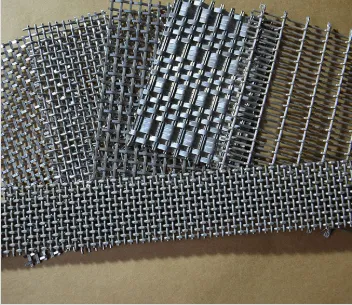Jan . 02, 2025 09:56 Back to list
Creative Uses of Decorative Mesh in Modern Interior Design
Decorative mesh has evolved from being a purely functional material to a stylish, versatile design element in modern interiors. With its ability to blend aesthetic appeal with practicality, decorative mesh is now a popular choice for architects and interior designers seeking innovative ways to enhance residential and commercial spaces. From room dividers to wall art, decorative mesh offers a wide range of creative applications that can transform a space, making it feel both contemporary and unique.

Adding Texture and Depth to Walls With Decorative Mesh
One of the most striking uses of deco mesh in modern interior design is as a wall treatment. Rather than relying on traditional wallpaper or paint, designers are increasingly turning to mesh to create depth, texture, and visual interest on walls. By installing mesh panels over painted walls, designers can add a dynamic, three-dimensional effect. The open weave of the mesh allows the wall color or underlying textures to peek through, creating a subtle yet compelling design element. This technique works particularly well in minimalist and industrial-style interiors, where clean lines and texture contrast can be emphasized.
In addition to its aesthetic appeal, mesh can be used to break up large expanses of walls, dividing them into sections or highlighting specific areas. For example, mesh can be used around a central focal point, such as a fireplace or artwork, to draw attention and frame the space.
Stylish Room Dividers and Partitions About Decorative Mesh
In open-plan living spaces, room dividers are an essential tool for creating distinct areas without losing the feeling of openness. Decorative mesh netting is a perfect material for these dividers because it provides separation while still allowing light to pass through, maintaining a sense of spaciousness. Mesh partitions can be used to define living, dining, and work areas, creating functional zones within larger spaces.
Unlike solid partitions, decorative mesh dividers allow for airflow and light penetration, which is particularly important in spaces with limited natural light. The material’s open weave can also create a sense of privacy without completely isolating areas from one another. This makes it ideal for both residential and commercial spaces, from modern loft apartments to trendy cafes and offices. Mesh dividers can be suspended from the ceiling, attached to sliding tracks, or framed within custom-built panels, offering flexibility in design.
Innovative Lighting Fixtures About Decorative Mesh
Decorative mesh is also being incorporated into lighting design, creating unique fixtures that combine functionality with artistry. The mesh's texture and shape lend themselves perfectly to lampshades, pendant lights, and sconces, where the interplay of light and shadow enhances the atmosphere of the room.
For example, a pendant light made from decorative mesh can cast intriguing shadows across the walls, creating a dynamic lighting effect. The mesh itself can be customized in various patterns, from fine weaves to geometric designs, allowing designers to experiment with different lighting moods. When paired with LED lighting, the mesh can produce a warm, diffused glow, ideal for creating an inviting ambiance in living rooms, dining areas, or bedrooms.
In commercial spaces like restaurants or cafes, mesh lighting fixtures can become focal points that draw attention and add a sense of sophistication to the space. The material’s reflective properties can also enhance the brightness of the light, making it ideal for areas that require functional illumination while still maintaining a decorative edge.
Mesh as a Material for Furniture Design About Decorative Mesh
Furniture design is another area where decorative mesh is making its mark. From tables and chairs to cabinets and storage units, mesh is being used as an innovative material to create both functional and aesthetically pleasing furniture pieces. The mesh can be incorporated into the construction of chairs, where it replaces traditional solid materials like wood or plastic for the seat and backrest. The result is a lightweight, modern look that still offers comfort and support.
In storage units, decorative mesh panels can be used in doors or cabinet sides to create a more breathable, transparent feel. This is especially useful in kitchens, bathrooms, or closets, where the mesh allows for air circulation while still maintaining a stylish and organized appearance. Mesh is also being used in shelving units, where it adds a contemporary touch while allowing the items stored inside to be partially visible, adding an element of visual intrigue.
Decorative Mesh for Window Treatments
While curtains and blinds have long been the go-to for window treatments, decorative mesh offers a refreshing alternative for those looking to experiment with design. Mesh window treatments provide a modern, airy feel, allowing natural light to filter through while still maintaining a degree of privacy. Mesh can be used to create sheer curtains that soften the light entering a room, creating a tranquil atmosphere without completely blocking the view.
Moreover, decorative mesh can be combined with other fabrics or materials to create layered window treatments that add complexity and dimension. Whether used as a primary covering or as an accent to more traditional materials, mesh provides an elegant, minimalist alternative to heavier, opaque curtains. Its ability to come in various colors, finishes, and weave patterns allows for customization that matches the overall design of the space.
share
-
What Are the Key Applications and Benefits of Chicken Wire Gabion and Related Retaining Solutions?
NewsJul.18,2025
-
What Are the Key Advantages and Applications of PVC Coated Gabion Wire Mesh and Related Solutions?
NewsJul.18,2025
-
Welded Gabion Mesh Solutions: Strength and Versatility in Construction
NewsJul.18,2025
-
Essential Solutions for Slope Stability: A Focus on Protective Nets
NewsJul.18,2025
-
Durable Solutions for Erosion Control and Construction: Galvanised Gabion Systems
NewsJul.18,2025
-
Constructing Functional Structures: The Art of Making Gabions
NewsJul.18,2025

